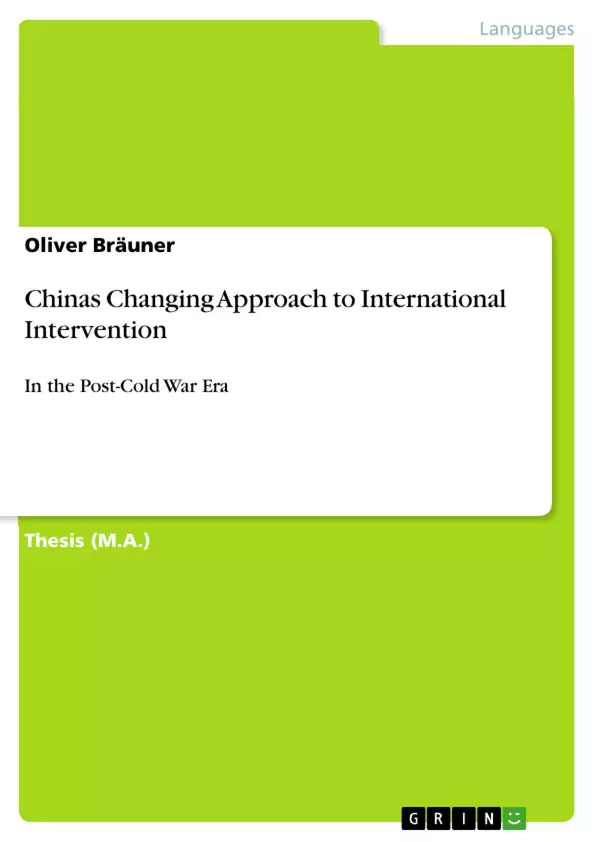This work tries to answer these questions by analyzing China’s changing policy on the principle of national sovereignty and international military intervention, especially since the end of
the Cold War era. The result is of course a much more complex picture than the one painted by the Western media: Beijing’s interpretation of national sovereignty is by no means static,
despite all its conservative rhetoric. In addition, China has increasingly acquiesced to some forms of international military intervention, while continuing to oppose it in certain cases.
Although there are some visible red lines, there seems to be no ideologically-driven Chinese strategy on international intervention. Beijing rather seems to follow a pragmatic approach of muddling through (mosuo, 摸索), testing a number of different approaches in order to find the best possible way to promote its interests.
This thesis is structured as follows: Chapter 2 provides an analysis of the general development of Chinese foreign policy since the end of the Cold War era. This chapter focuses especially on the issues and motivations that have dominated Chinese foreign policy in the past twenty years. It starts with a brief analysis of the Chinese foreign policy decision-making process and of the Chinese foreign policy think tank landscape. Chapter 3 looks into China’s changing position on the principle of national sovereignty. The chapter also discusses the historical development of the principle of national sovereignty, and the factors constraining and conducing change in the Chinese position towards it. Chapter 4 examines Beijing’s changing approach to international intervention. To illustrate this approach, two concepts of international military intervention will be examined: UN Peacekeeping Operations and a new concept, the Responsibility to Protect. The analysis of China’s position on these concepts will employ a mix of discourse analysis (comprising official statements and unofficial foreign policy elite views) and policy analysis. Thus following a Chinese saying, ‘listen to their words, and watch their actions’ (ting qi yan, guan qi xing, 聽其言, 觀其行). Finally, a summarization of the
findings and the corresponding conclusions can be found in chapter 5. The chapter ends with some policy recommendations for Western foreign policy decision-makers.
Inhaltsverzeichnis (Table of Contents)
- Chinese foreign policy after the Cold War
- Actors and foreign policy decision-making processes
- Party and government actors
- Think Tanks and foreign policy elite
- Development of Chinese foreign policy after the Cold War
- Competing goals and motivations
- Regime survival, economic development, nationalism
- Image policy: China's 'Peaceful Rise'
- Conclusion: Muddling through
- China's approach to sovereign change
- The 'New Sovereignty' debate
- China's changing position
- Factors constraining change
- Traditional Chinese conceptions of sovereignty
- Official PRC historiography and nationalism
- Example: The Taiwan conflict
- Factors conducive to change
- Growing global economic and political interests
- China's international socialization
- Example: Flexibility in border disputes
- Conclusion: Mixed signals
- China's changing position on international intervention
- UN Peacekeeping Operations
- Definition and controversies
- Historical development
- China's changing policy on UN PKO
- Foreign policy elite analysis
- Conclusion
- The Responsibility to Protect (R2P)
- From Humanitarian Intervention to R2P
- China's policy on R2P
- Foreign policy elite analysis
- Conclusion
- Conclusion: Limited progress
Zielsetzung und Themenschwerpunkte (Objectives and Key Themes)
This work aims to analyze the evolution of China's policy on national sovereignty and international military intervention since the end of the Cold War. It explores the factors that have influenced this change, including traditional Chinese conceptions of sovereignty, official PRC historiography and nationalism, growing global economic and political interests, and China's international socialization.
- China's changing approach to international intervention in the post-Cold War era
- The influence of traditional Chinese conceptions of sovereignty and nationalism
- The role of economic and political interests in shaping China's foreign policy
- The impact of China's international socialization on its approach to intervention
- The evolution of China's position on UN Peacekeeping Operations and the Responsibility to Protect (R2P)
Zusammenfassung der Kapitel (Chapter Summaries)
This section will explore the main themes, arguments, or narrative elements of each chapter. The summaries will aim for consistency in detail and will not include summaries of the conclusion, final chapter, or any sections containing major revelations or spoilers.
Chinese foreign policy after the Cold War
This chapter examines the actors and foreign policy decision-making processes in China after the Cold War, including the role of the Chinese Communist Party and government actors, as well as think tanks and foreign policy elites. It also explores the development of Chinese foreign policy in the post-Cold War era, highlighting competing goals and motivations such as regime survival, economic development, nationalism, and China's 'Peaceful Rise' image policy. Finally, the chapter concludes by examining China's foreign policy approach as a 'muddling through' strategy.
China's approach to sovereign change
This chapter delves into the debate surrounding the 'New Sovereignty' concept and China's evolving position on this principle. It explores the factors that constrain change, such as traditional Chinese conceptions of sovereignty, official PRC historiography and nationalism, and the example of the Taiwan conflict. The chapter also examines factors conducive to change, including growing global economic and political interests, China's international socialization, and the example of flexibility in border disputes. It concludes with an analysis of the mixed signals China sends on the issue of sovereign change.
Schlüsselwörter (Keywords)
This work focuses on key concepts related to China's changing approach to international intervention. These include national sovereignty, international military intervention, the Responsibility to Protect (R2P), UN Peacekeeping Operations, traditional Chinese conceptions of sovereignty, official PRC historiography, nationalism, economic and political interests, China's international socialization, and the 'Peaceful Rise' image policy.
- Quote paper
- Oliver Bräuner (Author), 2009, Chinas Changing Approach to International Intervention, Munich, GRIN Verlag, https://www.grin.com/document/144281



